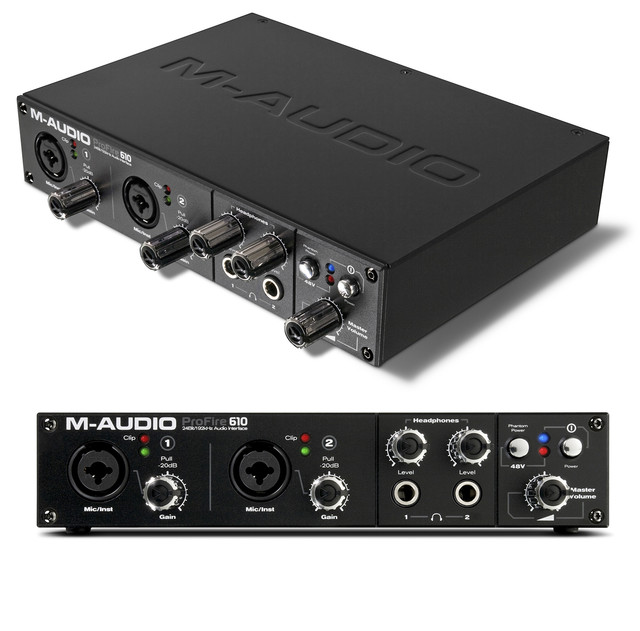
Avid/M-Audio’s ProFire 610 is a 24-bit/192 kHz FireWire audio interface with two pre-amps, a coaxial S/PDIF input and output, a user assignable master volume knob, and (don’t knock it!) good looks. If not attached to a computer, the 610 can be used as a standalone pre-amp.
The ProFire 610’s audio specifications are solid: microphone and line signal to noise ratios are both -108 dB (A-weighted) while frequency response is 20 Hz to 20 kHz +/- 0.2 dB across the board. Crosstalk is less than -105 dB except at the headphone outputs.
The 8.5-inch wide ProFire 610 is the “little brother” of M-Audio’s ProFire 2626 rack mount interface, but gives up little besides additional preamps, ADAT connectivity, and optical S/PDIF. The ProFire 610 could be considered the replacement for the FireWire 410 (released in 2004), but to me it is a substantial upgrade.
Controls and Inputs
Up front, what stands out from the black metal case are the two XLR inputs, each with phantom power, a 20 dB pad, and signal/peak LED indicator lights. Moving to the right, there are two 1/4-inch headphone jacks with accompanying volume knobs. Finally, there’s a master volume knob, a phantom power switch with indicator, and a power switch with indicator.
The back of the unit is not as glamorous as the front: from left to right, there’s a 12 volt DC/2.5 amp input, two FireWire 400 inputs, a MIDI in and out, S/PDIF in and out, eight 1/4-inch line outputs, and two 1/4-inch line outputs.
Drivers and Control Panel
M-Audio has released drivers for the ProFire 610 for Mac OS 10.7 back to 10.4.x. On the Windows side, drivers range from Windows 7 SP1 back to Windows XP SP2 (though if you insist on running XP you should definitely be running SP3!). Response is usually fairly quick to new operating systems: the ProFire 610 had a working Mac OS 10.7 driver a couple of weeks before Lion was actually released.
In the Mac OS, the control panel is accessed from a preference pane in System Preferences. In Windows, the control panel is accessed by double-clicking the red M-Audio icon in the system tray. In both Mac OS and Windows, the control panel allows routing of analog inputs, that all-important S/PDIF input and output, software returns, and analog outputs.
Usage Observations
This solidly built little interface has worked hard for me in the approximately 18 months I have owned it. It’s always connected via FireWire to my aging 2009 iMac 24-inch and it gets used for not only the obvious semi-pro functions (Pro Tools, Logic, GarageBand, etc.) but also for the less obvious and consumer functions (Roxio Toast, iTunes, games, etc.). Despite being at the end of an extended FireWire chain (three large hard disks), it has functioned reliably and flexibly — I have had no issues with the step-down from FireWire 800 to FireWire 400.
The ProFire 610’s Octane microphone preamps (seen mostly in higher-end M-Audio equipment) are excellent and have matched well with the various microphones I have used. The 610 can also drive different headphones quite capably and having two headphone outputs with independent volume is quite useful.
The ProFire 610 has been effective when taking input from my Sony PCM-R500 DAT (a relic from the last century that still gets a surprising amount of use). It locks solidly and musically onto the 48 kHz sampling frequency present in most of my old DAT tapes.
Finally, the ProFire 610’s analog outputs cleanly and precisely drive my M-Audio Studiophile LX4 near field monitors. Beyond the fidelity improvement (which is notable), it is extremely nice to be able to use the 610’s master volume control to get sound levels just so.
Conclusion
The M-Audio ProFire 610 is highly recommended for those with a FireWire 800 or FireWire 400 interface available and more than basic audio needs. It is available for approximately $400 from your finer online music equipment retailers.
John Mulhern III, posted 10/23/2011
For more information on M-Audio’s ProFire 610 visit: www.m-audio.com



